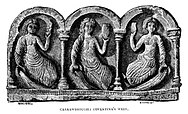Echtra Cormaic

| Part of a series on |
| Celtic mythologies |
|---|
 |
Echtra Cormaic or Echtra Cormaic i Tir Tairngiri (Cormac's Adventure in the Land of Promise) is a tale in Irish mythology which recounts the journey of the high-king Cormac mac Airt to the Land of Promise resided by the sea-god Manannán mac Lir.
Texts
[edit]The tale bears the full manuscript title "(Scel na Fir Flatha,) Echtra Cormaic i Tir Tairngiri ocus Ceart Claidib Cormaic in the text edited by Whitley Stokes, translated as "The Tale of the Ordeals, Cormac’s Adventure in the Land of Promise, and the Decision as to Cormac’s Sword". This edition uses the Book of Ballymote as base text, with readings from the Yellow Book of Lecan.[2] The two texts exhibit only minor differences, and are together classed as the first recension, whose composition 1150–1200 on linguistic evidence, based on some earlier exemplar which is thought to have existed.[3][4]
A second recension of the Echtra is found in the Book of Fermoy, edited and translated by Vernam Hall.[5][4] Eugene O'Curry also translated an excerpt from it.[6]
The story is also known as Fagháil Chraoibhe Cormaic,[7] and has been edited by Standish H. O'Grady, and translated as "How Cormac mac Airt Got his Branch".[8] This belongs in the third recension, in late Middle Irish. The manuscript used by O'Grady is unknown, but there are altogether 9 other paper MSS. in existence, none earlier than 1699.[3][4]
O'Grady's translation was condensed and reprinted in one of Joseph Jacobs's anthologies.[9] The chapter "His Three Calls to Cormac" is a retelling of the narrative by Lady Augusta Gregory in her book, Gods and Fighting Men.[10]
Summary
[edit]High King Cormac mac Airt meets a mysterious stranger at the Hill of Tara who bears a magical Silver Branch with three golden apples, which sends anyone to sleep if they hear its magic music. He takes the branch in exchange for three wishes of the stranger in exchange for three wishes to be redeemed at a later point in time. A year later, the stranger asks Cormac first for his daughter, then his son, and then his wife Eithne. Enraged, Cormac pursues the stranger across the countryside until he is lost in a magical fog. When the fog subsides, Cormac finds himself in a castle ruled by another stranger, who serves Cormac a pig which cannot be roasted until a true story is told for each of its quarters. Cormac relates how his wife and children were taken from him, allowing the pig to be fully roasted. When the meat is served, Cormac complains that he only dines in the company of fifty men; at this point the host recites a magical lullaby which puts Cormac to sleep.
When Cormac awakes, he finds himself in the company of fifty warriors, his wife, and his children. The host reveals himself to Manannán mac Lir, god of the sea and the true form of the stranger with the Silver Branch, who placed these trials for Cormac so that he may travel to his kingdom Tir na nÓg. He allows Cormac to return to Ireland with his family, the Silver Branch, and a magical cup which breaks if it detects a lie and reforms if it hears the truth, but warns Cormac that the treasures may only be his for his lifetime. After Cormac's death, the two artefacts are never again seen in Ireland.[11]
References
[edit]- Citations
- ^ The return of sea god sculpture Manannán Mac Lir, Derry Journal, 26 June 2015.
- ^ Stokes (1891) ed. Echtra Cormaic i Tir Tairngiri ocus Ceart Claidib Cormaic pp. 185–202, tr. "he Tale of the Ordeals, Cormac’s Adventure in the Land of Promise, and the Decision as to Cormac’s Sword" pp. 203–221
- ^ a b Hull (1949), p. 871.
- ^ a b c "Echtra Cormaic i Tír Tairngiri'Cormac's adventure in Tír Tairngiri'". Codecs. Stichting A. G. van Hamel voor Keltische Studies. Retrieved 23 February 2020.
- ^ Hull (1949), pp. 871–883.
- ^ O'Curry, Eugene (1873). "Lecture XXXIV The Musical Branch". On the Manners and Customs of the Ancient Irish. Vol. 3. Williams and Norgate. pp. 316–317.
- ^ Bruford, Alan (1966), "Gaelic Folk-Tales and Mediæval Romances: A Study of the Early Modern Irish 'Romantic Tales' and Their Oral Derivatives", Béaloideas, 34: 50, 280, doi:10.2307/20521320, JSTOR 20521320
- ^ O'Grady (1857) ed. Faghail Craoibhe Chormaic mhic Airt, tr. "How Cormac mac Airt Got his Branch" pp. 212–229
- ^ Jacobs, Joseph, ed. (1894). How Cormac Mac Art went to Faery. Illustrated by John D. Batten. London: David Nutt. pp. 204–209, notes p. 233.
{{cite book}}:|work=ignored (help) - ^ Gregory, Augusta, Lady (1905) [1903]. "Chapter XI. His Three Calls to Cormac". Gods and Fighting Men. Illustrated by John D. Batten. London: John Murray. pp. 115–121.
{{cite book}}: CS1 maint: multiple names: authors list (link); "Part I Book IV: His Three Calls to Cormac" (1903), Buckinghamshire: Colyn Smyth via sacred-texts.com - ^ "Echtrae Cormaic". Dictionary of Celtic Mythology. Oxford Reference. Retrieved 23 November 2022.
- Bibliography
- Hull, Vernam (September 1949), Hull, Vernam (ed.), "Echtra Cormaic Maic Airt, 'The Adventure of Cormac Mac Airt'", PMLA, 64 (4): 871–883, doi:10.2307/459637, JSTOR 459637, S2CID 163684387
- O'Grady, Standish Hayes, ed. (1857), "Faghail Craoibhe Chormaic mhic Airt" [How Cormac mac Airt Got his Branch], Toruigheacht Dhiarmuda Agus Ghrainne, Or The Pursuit After Diarmuid O'Duibhne and Grainne, the Daughter of Cormac Mac Airt, King of Ireland in the Third Century, Transactions of the Ossianic Society 3, pp. 212–229
- Stokes, Whitley, ed. (1891), "Echtra Cormaic i Tir Tairngiri ocus Ceart Claidib Cormaic" [The Tale of the Ordeals, Cormac’s Adventure in the Land of Promise, and the Decision as to Cormac’s Sword], Irische Texte, vol. 3, S. Hirzel, pp. 185–202 (text); 203–221 (translation); 222–229 (notes)


 French
French Deutsch
Deutsch